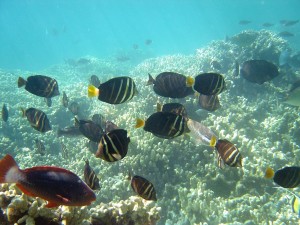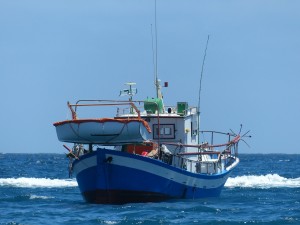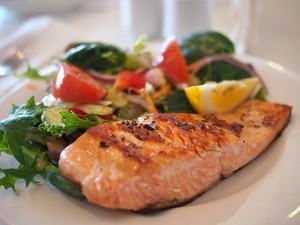Eating more seafood is a healthy choice. Seafood is a great source of lean protein and it also has many health benefits. Fish provides you with heart healthy omega-3 fatty acids, lowers your blood cholesterol, and provides you with ingredients that help improve your brain functions. Fish is also high in calcium for healthy bones, teeth and gums.
Many of us older folks need to supplement calcium in our diet for maintaining healthy bones and strength.
Fish is a super food that provides nutrition and livelihood for millions of people around the world. At the same time the ocean fish stocks are overfished and depleted from pollution.
 Not all fish in the ocean are equally good for you, and some species of fish are even endangered. Depending on the surrounding habitat, some fish can contain high amounts of mercury or PCBs. Overfishing has also caused imbalances in the marine life. Eating the right kind of fish will allow you to stay healthy while keeping the natural and ecological balances undisturbed in the ocean, as much as possible.
Not all fish in the ocean are equally good for you, and some species of fish are even endangered. Depending on the surrounding habitat, some fish can contain high amounts of mercury or PCBs. Overfishing has also caused imbalances in the marine life. Eating the right kind of fish will allow you to stay healthy while keeping the natural and ecological balances undisturbed in the ocean, as much as possible.
A recent study shows that major fish species consumed today, including scallops, tuna, lobster, and flounder, could become extinct by the middle of the century (Worldwatch Institute). The main reason for depletion of ocean fish stocks and accelerating loss of fish populations and species is because of human interference with ocean ecosystems.
“But fishery collapses are not inevitable,” says Brian Halweil, senior researcher at the Worldwatch Institute. Below are some tips on how to continue enjoying the benefits of fish without depleting the ocean fish stocks.
1. Eat lower on the food chain
Larger fish tend to gather more fat and toxic elements because they live longer. Smaller fish are less toxic and they tend to be plentiful in the ocean. Small seafood such as squid, oysters, mussels, mackerel, and sardines are great because they contain less mercury.
 Eat less of the big fish such as salmon, shark, tuna, or swordfish because “These are among the most vulnerable populations, and also the fish that live the longest, have the most fat, and accumulate the most toxins over their lifespan.” says Brian Halweil.
Eat less of the big fish such as salmon, shark, tuna, or swordfish because “These are among the most vulnerable populations, and also the fish that live the longest, have the most fat, and accumulate the most toxins over their lifespan.” says Brian Halweil.
Eating lower on the food chain not only reduces your exposure to toxins, but is more sustainable. Just think of the volume of food that went into a full-grown tuna, for example, compared to an equal amount of mussels. Per pound that we eat, we consume exponentially less resources by eating an animal that ate less.
2. Buy local
Buying locally grown seafood has many environmental benefits. Try buying fish grown and raised in your area. The USA has strict fishing and environmental regulations, and so, buying fish from a farm in the United States will ensure that your fish was grown in ethical and sustainable manner. Eating local will also ensure that there was no energy wasted while transporting the fish.
3. Know how your fish was caught
 Make sure that the fish you are eating are harvested using sustainable methods. Using hooks and lines does not impact the environment. Also, using nets that have bigger mesh for the young ones to escape is a sustainable method.
Make sure that the fish you are eating are harvested using sustainable methods. Using hooks and lines does not impact the environment. Also, using nets that have bigger mesh for the young ones to escape is a sustainable method.
Read the labels on your seafood or ask the restaurant that serves you food for information about the fish you are eating. Look for The Marine Stewardship Council certified seafood that is caught or raised in a sustainable, environmentally friendly manner. These products will display the MSC seal. (Sustainable Seafood Guide, Healthy Delicious Seafood Guide | NRDC)
4. Buy from trusted retailers
Certain retailers in the United States have set higher standards for supplying fresh food and so, you can be sure that the food you buy from them comes from trusted sources. Some food stores support long-term sustainable seafood plants.
Find guides to good retailers at the Conservation Alliance for Sustainable Seafood Solutions and Greenpeace. You can find more information on sustainable seafood at Seafood Selector.
 Selecting what seafood you eat will ensure healthy and sustainable fish stock in the ocean and ocean ecology. Tips given in this article are aimed to helping restore and conserve healthy ocean ecosystems, while ensuring that consumers enjoy safe, eco-friendly seafood. Our goal is to promote aquaculture so that fishing businesses across the world can thrive.
Selecting what seafood you eat will ensure healthy and sustainable fish stock in the ocean and ocean ecology. Tips given in this article are aimed to helping restore and conserve healthy ocean ecosystems, while ensuring that consumers enjoy safe, eco-friendly seafood. Our goal is to promote aquaculture so that fishing businesses across the world can thrive.
Would you like to start your own fish farming business? We’ll show you how! Click here to download Your FREE eBook to Unleash the Entrepreneur in You!
We would appreciate your comments and engagement at our social media page, so please visit our Facebook page to post your comment.
Do you have a question or comment regarding this article? Please post these in the comment box below.
For any question regarding aquaculture, or to get in touch with us, please call our office at: (303) 495-3705 or Click here to Book A Meeting with us.
Source: WorldWide Aquaculture
Related articles:
- Freshwater Shrimp Farming – Harvesting Storage & Economic Feasibility | WorldWide Aquaculture
- 5 Reasons Why You Should Eat More Fish | WorldWide Aquaculture
- Eating Sustainable Seafood – Three Tips to Steer Clear of Fisheries Collapse | Worldwatch Institute
- Sustainable Seafood Guide, Healthy Delicious Seafood Guide | NRDC



